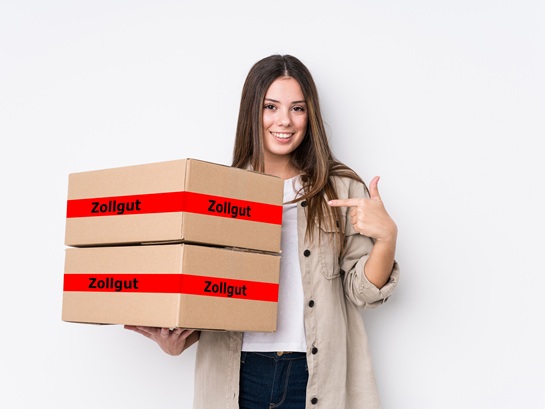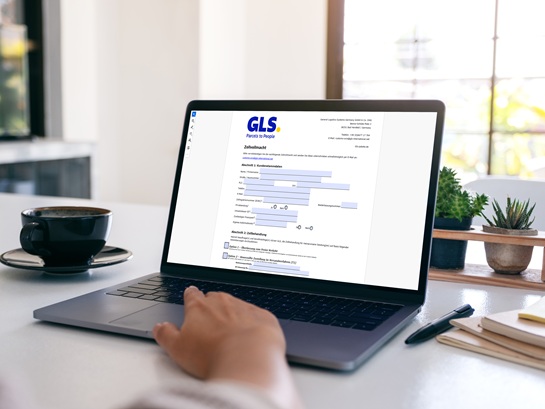Import customs
Customs duties are government taxes levied on goods crossing national borders. In addition, customs includes a complex set of rules that controls and regulates the import, export, and transit of goods. The aim is to regulate international trade, protect the domestic economy, and ensure compliance with legal requirements. Customs duties are generally levied on imports (and exports) between a non-EU country and the European Union (EU). There is free movement of goods between EU member states and, as a rule, no customs duties are levied.

Import customs clearance
Import customs clearance affects customers when they order goods from a non-EU country (e.g., Switzerland, Great Britain, Norway, etc.) and these goods are then delivered to them. Before they can freely dispose of the goods (non-Union goods), they must first be declared to customs. Customs then checks the contents and the relevant documents, e.g. by means of a customs application prepared by us. Only after customs clearance can customers freely dispose of the goods within the EU.
Customs duties are government revenues levied by the customs authorities of the importing country and paid directly into the respective budget. In international trade, customs duties serve to regulate, control, and secure cross-border trade:
- Protecting the domestic economy from unfair competition from particularly cheap imported goods;
- Compliance with legal requirements regarding the import of prohibited or restricted goods;
- Securing taxes (such as customs duties, import sales tax, and excise duties);
- Trade control as a basis for economic and foreign trade policy.
The amount of customs duties for international shipments is determined individually based on the respective goods and their characteristics. The following factors are particularly important for the calculation:
- Commodity code (HS-Code): The customs tariff specifies the customs duty rate for a product group.
- Value of goods: This is usually based on the transaction value (invoice amount including packaging and shipping).
- Country of origin: Different agreements apply depending on the country of origin of the goods.
In addition to customs duties, there are often additional fees that can vary depending on the type of goods, destination country, and shipping method. The most common fees include:
- Import sales tax (VAT): This tax is similar to value added tax and is levied on the value of the goods including customs duties and transport costs. In many countries, it is mandatory and payable upon import.
- Excise duties: Separate excise duties are levied on certain products such as tobacco, alcohol, or fuel, which are independent of the customs duty.
- Other fees (e.g., environmental taxes, security fees, or administrative fees)
As an experienced logistics partner, we support you in presenting all charges transparently and getting your goods to their destination safely and cost-efficiently.
Not every cross-border shipment of goods is automatically subject to customs duties. In certain cases, shipments may remain duty-free or benefit from reduced duty rates. Here are a few examples:
- Trade within the European Union (EU): There is free movement of goods within the EU. This means that no customs duties are payable on goods transported between member states.
- Free trade and preferential agreements: Many countries have concluded bilateral or multilateral trade agreements that provide for customs concessions or exemptions for certain goods.
- Low-value shipments: Customs duties may not apply to shipments with a value below a certain exemption limit.
- Special product groups: Special customs exemptions or exceptions often apply to certain products, such as samples, gifts, or goods for personal use.
*Short-term changes to duty-free limits are possible, e.g. due to political decisions by the respective importing countries.
| Country/Region | Duty-free limit (value of goods) | Note |
| Australia | Approx. 1000 AUD | Exemption limit for most shipments of goods |
| Canada | Approx. 20 CAD for gifts / 40 CAD for personal items | Higher exemption limits for gifts and personal shipments |
| China | Approx. 50 EUR | Low-value shipments are usually duty-free |
| European Union | No customs duties on intra-Community trade in goods | Free movement of goods between EU members |
| Switzerland | Approx. 65 CHF | Shipments below this limit are duty-free |
| United Kingdom | Approx. 135 GBP | Shipments below this limit are duty-free |
Release for free circulation is a customs procedure whereby goods imported from a non-EU country are transferred into the EU economic cycle. All applicable customs duties, import sales taxes, and, where applicable, excise duties are levied, and all trade policy measures (e.g., import bans, licenses, or product safety regulations) are checked. Only after this procedure has been completed may the goods be freely sold, used, or further processed.
Import customs declaration
The import customs declaration is a procedure by which goods from a non-EU country are declared to customs in order to be released for free circulation in the EU.
Returned goods
The returned goods procedure is a special customs procedure whereby goods can be re-imported into the EU free of customs duties and taxes if they were previously exported from there. The requirements for the returned goods procedure are:
- The goods must be returned unchanged
- Proof of the original export must be provided (e.g., with export documents (outgoing invoice, export declaration))
- The return must take place within three years
If these conditions are met, customs duties and import sales tax are usually not payable on re-importation.
IMPOST (IOSS customs procedure / Inc 18)
The IOSS customs procedure (Import One-Stop Shop) is a simplified taxation procedure for the import of low-value goods from non-EU countries into the EU. It was introduced in 2021. Important features of the IOSS procedure:
- Applies to goods with a value of less than €150 (excluding shipping costs and taxes)
- Upon import, import sales tax is not levied by customs, meaning that the customer does not have to pay any additional duties
- The shipment must be delivered to a private individual
- The exporter's valid IOSS number must be available for customs clearance under the IOSS procedure
The T1 procedure is a customs transit procedure within the EU and other affiliated countries (e.g., EFTA states) whereby non-Union goods (i.e., goods that have not yet been cleared through customs and taxed) may be transported from one place to another under customs supervision. Features of the T1 procedure:
- The goods remain unchanged for customs purposes throughout the entire transport—they are neither cleared through customs nor taxed.
- You must be registered with German customs as an authorized consignee, which you can prove to us with your AC authorization number.
- The procedure ends when the goods arrive at the authorized consignee and are either cleared through customs or transferred to another procedure.
Destruction by customs should always be the last resort. In this case, the undeclared goods are destroyed under customs supervision and are no longer returned to the economic cycle.
Once we have received your customs authorization and all other customs clearance documents are complete, we will begin customs clearance immediately. However, if you, as the declarant, would like to be informed in advance about our customs clearance or check the relevant documents, you can register with us as an “advance notification customer”. As soon as we receive notification of a shipment to you, we will contact you to clarify the relevant customs clearance.
Customs clearance information includes all data and documents required for completing customs formalities when importing goods. Only when these are complete can the shipment be cleared without delay. The following documents are required for customs clearance.

Customs authorization
With reference to Art. 150 in conjunction with Art. 19 UCC (choice of customs procedure), we require a customs authorization from you in order to clear the shipment on your behalf. Customs clearance is carried out on your behalf, i.e., you act as the importer of the shipment and at the same time as the customs declarant. We, General Logistics Systems Germany GmbH & Co. OHG, act exclusively as your representative and on your behalf. Your detailed rights and obligations can be found in the Union Customs Code (UCC, e.g. Article 15).
Commercial invoice
In addition to the customs authorization, you always need a commercial invoice containing the most important information for customs clearance. The required information is explained in more detail below.
The EORI number (Economic Operators Registration and Identification) is an identification number for economic operators involved in trade with third countries. The structure of a German EORI number is as follows: DE + 7 or 15 digits.
mport customs declarations can only be filed with German customs if you have a valid EORI number linked to an address in the EU. You can check that your EORI number is correct using the European Union database. If you do not yet have an EORI number, you can apply for one free of charge from German customs.
The IOSS number (Import One-Stop Shop) is a special VAT identification number used for the simplified import of goods into the EU. It may only be used for shipments to private individuals with a maximum value of €150.00 (excluding shipping costs and taxes). The structure of an IOSS number is as follows: IM + 10 digits.
n Germany, you can apply for an IOSS number via the Federal Central Tax Office..
- Invoice number
- Contact details of sender/exporter: including address, telephone number, and email address
- Contact details of recipient/importer: including address, telephone number, and email address
- Complete description of goods: including intended use and material (e.g., “100% cotton sweater, long-sleeved, dark blue, size M, for men”)
- Quantity (e.g., number of items in the package)
- Commodity/customs tariff number: To find the commodity tariff number for your goods, please refer to the Customs Tariff Database of the European Union (TARIC).
- Country of origin: Place of manufacture of the goods
- Realistic value of the goods
- Uniform currency
- Preference: Preferences are preferential customs treatment for goods from certain countries and territories. They are used to prove the origin of the goods. Exports and imports can be made more cost-effective with the help of preferences. For more information on how to provide valid proof of preference, please refer to the WuP customs page (origin of goods and preferences).
After customs clearance, the final import duty assessment can be made available to the importer in digital form. If you would like this option, please contact
For imports from customs relations, the system generates and transmits an invoice in ZUGFeRD 2.2 format for the settlement of customs clearance services, customs duties, and import sales tax. If you require an X-invoice, please contact
We kindly ask you to check the import duty assessment for accuracy upon receipt of the invoice. A request for a refund/correction can be made in writing by email to
Do you have open questions? If you have any questions about import clearance for parcel shipments or need assistance with specific import issues, please do not hesitate to contact us. You can reach our team at the following email address: